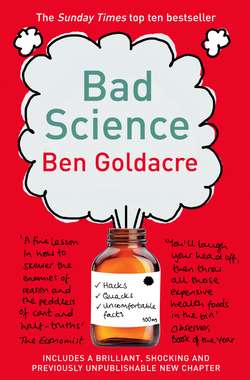Читать книгу Bad Science - Ben Goldacre - Страница 23
The placebo on trial
ОглавлениеIn most studies we don’t have a ‘no treatment’ group to compare both the placebo and the drug against, and for a very good ethical reason: if your patients are ill, you shouldn’t be leaving them untreated simply because of your own mawkish interest in the placebo effect. In fact, in most cases today it is considered wrong even to use a placebo in a trial: whenever possible you should compare your new treatment against the best pre-existing, current treatment.
This is not just for ethical reasons (although it is enshrined in the Declaration of Helsinki, the international ethics bible). Placebo-controlled trials are also frowned upon by the evidence-based medicine community, because they know it’s an easy way to cook the books and get easy positive trial data to support your company’s big new investment. In the real world of clinical practice, patients and doctors aren’t so interested in whether a new drug works better than nothing, they’re interested in whether it works better than the best treatment they already have.
There have been occasions in medical history where researchers were more cavalier. The Tuskegee Syphilis Study, for example, is one of America’s most shaming hours, if it is possible to say such a thing these days: 399 poor, rural African-American men were recruited by the US Public Health Service in 1932 for an observational study to see what happened if syphilis was left, very simply, untreated. Astonishingly, the study ran right through to 1972. In 1949 penicillin was introduced as an effective treatment for syphilis. These men did not receive that drug, nor did they receive Salvarsan, nor indeed did they receive an apology until 1997, from Bill Clinton.
If we don’t want to do unethical scientific experiments with ‘no treatment’ groups on sick people, how else can we determine the size of the placebo effect on modern illnesses? Firstly, and rather ingeniously, we can compare one placebo with another.
The first experiment in this field was a meta-analysis by Daniel Moerman, an anthropologist who has specialised in the placebo effect. He took the trial data from placebo-controlled trials of gastric ulcer medication, which was his first cunning move, because gastric ulcers are an excellent thing to study: their presence or absence is determined very objectively, with a gastroscopy camera passed down into the stomach, to avoid any doubt.
Moerman took only the placebo data from these trials, and then, in his second ingenious move, from all of these studies, of all the different drugs, with their different dosing regimes, he took the ulcer healing rate from the placebo arm of trials where the ‘placebo’ treatment was two sugar pills a day, and compared that with the ulcer healing rate in the placebo arm of trials where the placebo was four sugar pills a day. He found, spectacularly, that four sugar pills are better than two (these findings have also been replicated in a different dataset, for those who are switched on enough to worry about the replicability of important clinical findings).
